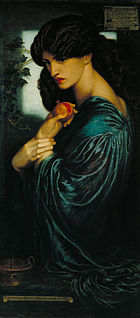
The Pre-Raphaelite Brotherhood was a group of English painters, poets, and art critics, founded in 1848 by William Holman Hunt, John Everett Millais, Dante Gabriel Rossetti, William Michael Rossetti, James Collinson, Frederic George Stephens and Thomas Woolner who formed a seven-member "Brotherhood" modelled in part on the Nazarene movement. The Brotherhood was only ever a loose association and their principles were shared by other artists of the time, including Ford Madox Brown, Arthur Hughes and Marie Spartali Stillman. Later followers of the principles of the Brotherhood included Edward Burne-Jones, William Morris and John William Waterhouse.
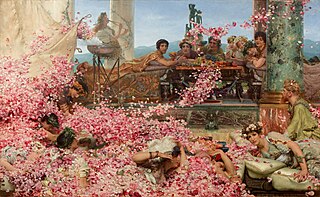
The Roses of Heliogabalus is an 1888 painting by the Anglo-Dutch artist Sir Lawrence Alma-Tadema depicting the young Roman emperor Elagabalus hosting a banquet.

Frederic Leighton, 1st Baron Leighton,, known as Sir Frederic Leighton between 1878 and 1896, was a British painter, draughtsman and sculptor. His works depicted historical, biblical, and classical subject matter in an academic style. His paintings were enormously popular, and expensive, during his lifetime, but fell out of critical favour for many decades in the early 20th century.
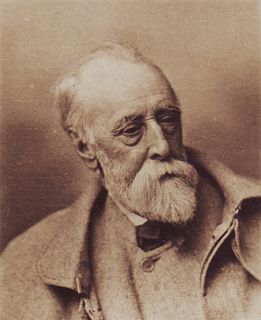
George Frederic Watts was a British painter and sculptor associated with the Symbolist movement. He said "I paint ideas, not things." Watts became famous in his lifetime for his allegorical works, such as Hope and Love and Life. These paintings were intended to form part of an epic symbolic cycle called the "House of Life", in which the emotions and aspirations of life would all be represented in a universal symbolic language.
Events from the year 1877 in art.

The Art Gallery of New South Wales (AGNSW), located in The Domain in Sydney, New South Wales, Australia, is the most important public gallery in Sydney and one of the largest in Australia. The Gallery's first public exhibition opened in 1874. Admission is free to the general exhibition space, which displays Australian art, European and Asian art. A dedicated Asian Gallery was opened in 2003.

The Royal Birmingham Society of Artists or RBSA is an art society, based in the Jewellery Quarter in Birmingham, England, where it owns and operates an art gallery, the RBSA Gallery, on Brook Street, just off St Paul's Square. It is both a registered charity, and a registered company.
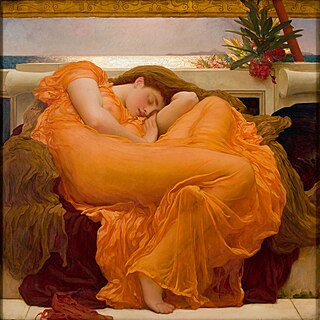
Flaming June is a painting by Sir Frederic Leighton, produced in 1895. Painted with oil paints on a 47-by-47-inch square canvas, it is widely considered to be Leighton's magnum opus, showing his classicist nature. It is thought that the woman portrayed alludes to the figures of sleeping nymphs and naiads the Greeks often sculpted.

Dorothy Dene, born Ada Alice Pullen, was an English stage actress and artist's model for the painter Frederick Leighton and some of his associates. Dene was considered to have a classical face and figure and a flawless complexion. Her height was above average and she had long arms, large violet eyes and abundant golden chestnut hair.

A Private View at the Royal Academy, 1881 is a painting by the English artist William Powell Frith exhibited at the Royal Academy of Arts in London in 1883. It depicts a group of distinguished Victorians visiting the Royal Academy Summer Exhibition in 1881, just after the death of the Prime Minister Benjamin Disraeli, whose portrait by John Everett Millais was included on a screen at the special request of Queen Victoria. The room is Gallery III, the largest and most imposing room at Burlington House.

John Reinhard Weguelin was an English painter and illustrator, active from 1877 to after 1910. He specialized in figurative paintings with lush backgrounds, typically landscapes or garden scenes. Weguelin emulated the neo-classical style of Edward Poynter and Lawrence Alma-Tadema, painting subjects inspired by classical antiquity and mythology. He depicted scenes of everyday life in ancient Greece and Rome, as well as mythological subjects, with an emphasis on pastoral scenes. Weguelin also drew on folklore for inspiration, and painted numerous images of nymphs and mermaids. His subjects were similar to those of his contemporary, John William Waterhouse, who also specialized in painting the female figure against dramatic backgrounds, but unlike Waterhouse, many of Weguelin's subjects are nude or scantily-clad. Weguelin was particularly noted for his realistic use of light.

Laura Theresa Alma-Tadema, Lady Alma-Tadema was an English painter specialising in domestic and genre scenes of women and children. Eighteen of her paintings were exhibited at the Royal Academy. Her husband, Lawrence Alma-Tadema, was also a painter.

Hope is a Symbolist oil painting by the English painter George Frederic Watts, who completed the first two versions in 1886. Radically different from previous treatments of the subject, it shows a lone blindfolded female figure sitting on a globe, playing a lyre that has only a single string remaining. The background is almost blank, its only visible feature a single star. Watts intentionally used symbolism not traditionally associated with hope to make the painting's meaning ambiguous. While his use of colour in Hope was greatly admired, at the time of its exhibition many critics disliked the painting. Hope proved popular with the Aesthetic Movement, who considered beauty the primary purpose of art and were unconcerned by the ambiguity of its message. Reproductions in platinotype, and later cheap carbon prints, soon began to be sold.
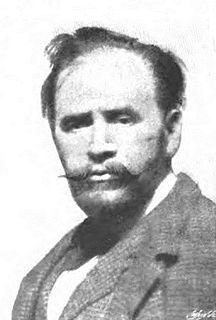
Robert Fowler (1853–1926) was a Scottish artist who painted mythological scenes and landscapes.

Cimabue's Celebrated Madonna, originally called Cimabue's [Celebrated] Madonna [is] Carried in Procession through the Streets of Florence, is an oil painting by English artist Frederic Leighton. Measuring more than two metres tall and more than five metres wide, the canvas was painted by Leighton from 1853 to 1855 in Rome as his first major work. Since 1988 it has been displayed in the National Gallery, London, on long-term loan from the Royal Collection, where it has been previously hung prominently, high above the main vestibule, directly beyond the entrance to the gallery.
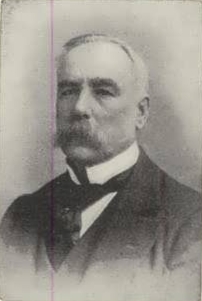
Henry Jamyn Brooks (1839–1925) was a British painter, particularly known for his pictures of meetings and events, in which many individuals are personally identifiable. He painted royalty, and portraits of civic leaders and military people, and was also a photographer.

James Ward (1851–1924) Belfast-born artist, author and teacher. Ward was an important figure in the Irish and British art scene in the late 19th and early 20th century. He is best known in Ireland for his striking murals in Dublin City Hall depicting scenes from Dublin’s history. Besides being the author of influential textbooks, Ward was an innovative teacher who taught and inspired a generation of Irish artists.
Jean Bellette was an Australian artist. Born in Tasmania, she was educated in Hobart and at Julian Ashton's art school in Sydney, where one of her teachers was Thea Proctor. In London she studied under painters Bernard Meninsky and Mark Gertler.

The Finding of Moses is a 1904 painting by the Anglo-Dutch artist Lawrence Alma-Tadema. It was one of his last major works before his death in 1912, but quickly fell out of favour; according to rumour, it was sold in the 1950s for its frame. After appreciation of Victorian painting was renewed towards the end of the 20th century, it was described in an auction catalogue in 1995 as "the undisputed masterpiece of [Alma-Tadema's] last decade, as well as a late flowering of the nineteenth-century's love-affair with Egypt". It was sold to a private collector at auction in 2010 for nearly US$36 million.

An Athlete Wrestling with a Python was the first of three bronze sculptures produced by the British artist Frederic Leighton. Completed in 1877, the sculpture was a departure for Leighton, and heralded the advent of a new movement, New Sculpture, taking realistic approach to classical models. It has been described as a "sculptural masterpiece" and as "possibly Leighton's greatest contribution to British art". Despite its indebtedness to the Classical tradition, it can be understood as one of the first stirrings of modern sculpture in Britain as well as in Europe. The Athlete was arguably the most influential piece of English sculpture of the 19th century.


















